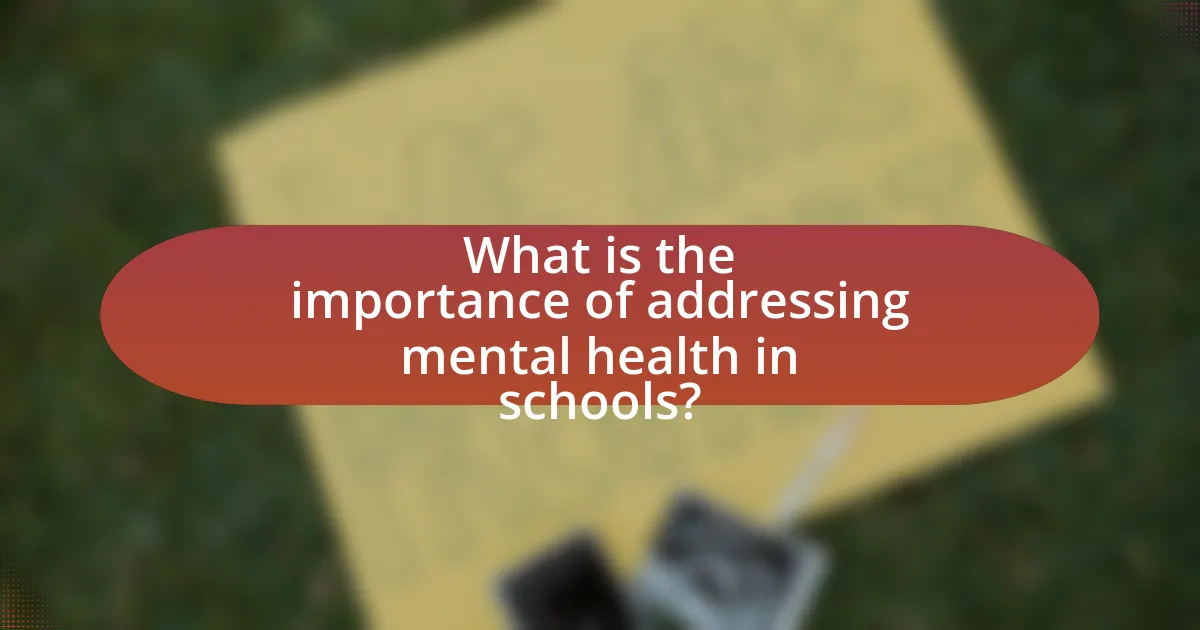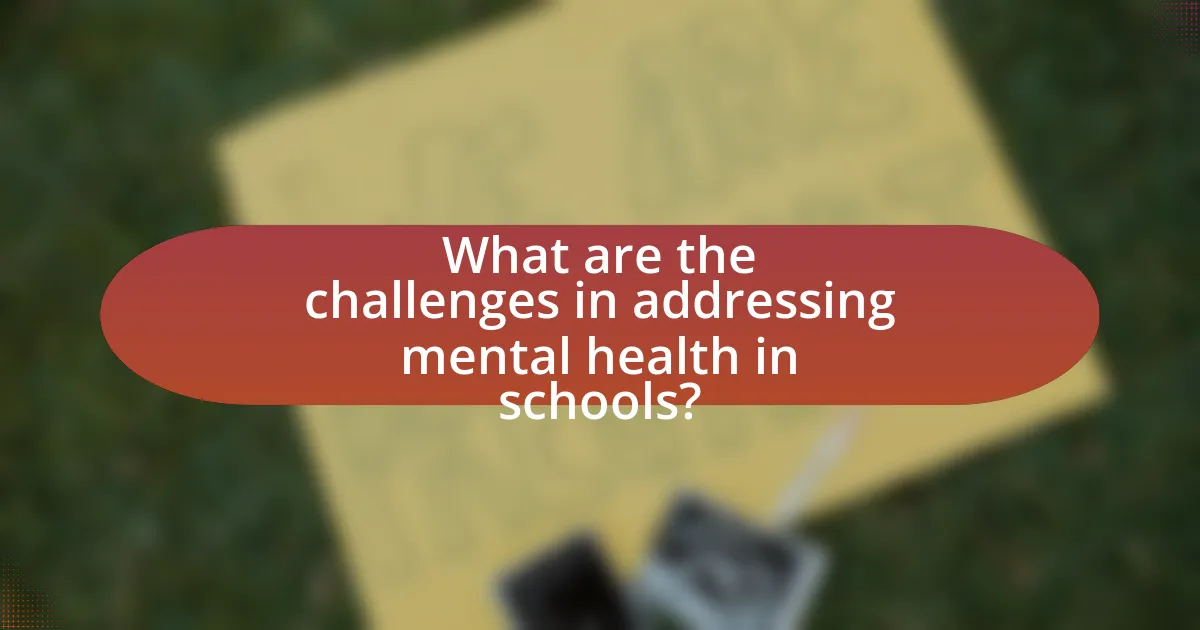The article focuses on the critical importance of addressing mental health in schools and the resources available for students. It highlights how mental health issues can adversely affect academic performance, social interactions, and overall development, with approximately 1 in 5 children experiencing mental health disorders. The article discusses the impact of mental health on learning, the signs of mental health issues, and the significance of early intervention. It also outlines the role of schools in supporting mental health, the types of services offered, and the challenges faced in providing adequate resources. Additionally, it emphasizes best practices for integrating mental health education into the curriculum and the importance of community partnerships in enhancing support systems for students.

What is the importance of addressing mental health in schools?
Addressing mental health in schools is crucial for fostering a supportive learning environment and enhancing student well-being. Mental health issues can significantly impact academic performance, social interactions, and overall development. Research indicates that approximately 1 in 5 children and adolescents experience mental health disorders, which can lead to lower grades, increased absenteeism, and higher dropout rates. By implementing mental health programs and resources in schools, educators can identify and support students in need, ultimately promoting better educational outcomes and healthier school communities.
How does mental health impact student learning and development?
Mental health significantly impacts student learning and development by influencing cognitive functions, emotional regulation, and social interactions. Students experiencing mental health issues, such as anxiety or depression, often face difficulties in concentrating, retaining information, and engaging in classroom activities, which can lead to lower academic performance. Research indicates that approximately 20% of adolescents experience a mental health disorder, which can hinder their educational attainment and overall development. Furthermore, mental health challenges can affect relationships with peers and teachers, leading to social isolation and decreased motivation to participate in school. Addressing mental health in educational settings is crucial, as studies show that schools implementing mental health resources and support systems can improve student outcomes, enhance engagement, and foster a positive learning environment.
What are the signs of mental health issues in students?
Signs of mental health issues in students include changes in academic performance, withdrawal from social interactions, and noticeable mood swings. Students may exhibit a decline in grades, increased absenteeism, or a lack of interest in previously enjoyed activities, indicating potential distress. Additionally, physical symptoms such as fatigue, changes in appetite, or sleep disturbances can also signal underlying mental health concerns. Research indicates that approximately 1 in 5 children and adolescents experience a mental health disorder, emphasizing the importance of recognizing these signs early for timely intervention.
Why is early intervention crucial for mental health in schools?
Early intervention is crucial for mental health in schools because it significantly improves student outcomes and reduces the long-term impact of mental health issues. Research indicates that early identification and support can lead to a 50% reduction in the severity of mental health problems, allowing students to achieve better academic performance and social functioning. For instance, a study published in the Journal of School Psychology found that students who received early mental health interventions showed a marked decrease in behavioral issues and improved emotional well-being. This evidence underscores the importance of proactive measures in educational settings to foster a supportive environment for students’ mental health.
What role do schools play in supporting mental health?
Schools play a crucial role in supporting mental health by providing resources, creating a safe environment, and promoting awareness. They implement programs that focus on social-emotional learning, which helps students develop coping skills and resilience. Research indicates that schools with mental health initiatives see improved student outcomes; for example, a study published in the Journal of School Psychology found that school-based mental health services significantly reduce symptoms of depression and anxiety among students. Additionally, schools often collaborate with mental health professionals to offer counseling services, ensuring that students have access to necessary support.
How can schools create a supportive environment for mental health?
Schools can create a supportive environment for mental health by implementing comprehensive mental health programs that include counseling services, mental health education, and peer support initiatives. Research indicates that schools with dedicated mental health resources, such as trained counselors and mental health awareness programs, significantly improve student well-being and academic performance. For instance, a study published in the Journal of School Psychology found that schools with mental health services reported a 20% decrease in behavioral issues and a 15% increase in student engagement. Additionally, fostering an inclusive culture that encourages open discussions about mental health can reduce stigma and promote help-seeking behavior among students.
What policies can schools implement to address mental health?
Schools can implement comprehensive mental health policies that include regular mental health screenings, access to counseling services, and mental health education programs. Regular screenings can identify students in need of support early, while access to counseling services ensures that students receive timely help. Mental health education programs can promote awareness and reduce stigma, equipping students with coping strategies. Research indicates that schools with such policies report improved student well-being and academic performance, highlighting the effectiveness of proactive mental health initiatives.
What resources are available for students’ mental health in schools?
Schools provide various resources for students’ mental health, including counseling services, mental health education programs, and peer support groups. Counseling services typically involve trained school counselors or psychologists who offer individual or group therapy sessions, helping students cope with emotional and psychological challenges. Mental health education programs aim to raise awareness about mental health issues, teaching students about stress management, coping strategies, and the importance of seeking help. Peer support groups create a safe space for students to share experiences and support one another, fostering a sense of community and belonging. These resources are essential for promoting mental well-being and addressing the mental health needs of students effectively.
What types of mental health services do schools typically offer?
Schools typically offer a range of mental health services, including counseling, psychological assessments, crisis intervention, and mental health education programs. Counseling services provide students with individual or group therapy to address emotional and behavioral issues. Psychological assessments help identify specific mental health needs and inform appropriate interventions. Crisis intervention services are available for students experiencing acute mental health crises, ensuring immediate support. Additionally, mental health education programs aim to raise awareness and reduce stigma surrounding mental health issues among students and staff. These services are essential for promoting student well-being and academic success.
How do counseling services function within schools?
Counseling services within schools function by providing mental health support, guidance, and resources to students. These services typically include individual counseling, group therapy, crisis intervention, and educational workshops aimed at promoting emotional well-being. Research indicates that schools with comprehensive counseling programs can significantly improve students’ academic performance and social skills, as evidenced by a study published in the Journal of School Psychology, which found that effective counseling services lead to a 20% increase in student engagement and a reduction in behavioral issues.
What role do school psychologists play in supporting students?
School psychologists play a crucial role in supporting students by addressing their mental health needs and promoting academic success. They provide assessment, intervention, and counseling services to help students cope with emotional, social, and behavioral challenges. Research indicates that school psychologists contribute to improved student outcomes, such as enhanced academic performance and better social skills, by implementing evidence-based practices and collaborating with educators and families. Their expertise in mental health allows them to identify at-risk students and develop tailored support plans, ensuring that students receive the necessary resources to thrive in a school environment.
How can students access mental health resources in schools?
Students can access mental health resources in schools through school counselors, mental health professionals, and designated wellness centers. School counselors are trained to provide support and can guide students to appropriate resources, including therapy and support groups. Many schools also collaborate with local mental health organizations to offer services on-site, ensuring students have immediate access to help. According to the National Association of School Psychologists, 95% of schools provide mental health services, highlighting the widespread availability of these resources.
What steps should students take to seek help?
Students should first identify the specific issue they need help with, whether it be academic, emotional, or social. Next, they should reach out to a trusted adult, such as a teacher, school counselor, or parent, to discuss their concerns. Following that, students can utilize available school resources, such as mental health services or support groups, to access professional help. Research indicates that early intervention and support can significantly improve mental health outcomes for students, highlighting the importance of seeking help promptly.
How can parents and guardians support their children in accessing these resources?
Parents and guardians can support their children in accessing mental health resources by actively engaging in open conversations about mental health and the available support systems. By fostering an environment where children feel comfortable discussing their feelings, parents can encourage them to seek help when needed. Additionally, parents can research and identify local mental health services, school counselors, and online resources, ensuring that their children are aware of these options. Studies show that parental involvement significantly increases the likelihood of children utilizing mental health resources, as children are more likely to seek help when they know their parents support their mental well-being.

What are the challenges in addressing mental health in schools?
The challenges in addressing mental health in schools include stigma, lack of resources, and insufficient training for staff. Stigma surrounding mental health often prevents students from seeking help, as they fear judgment from peers and adults. Additionally, many schools face budget constraints that limit access to mental health professionals and programs, making it difficult to provide adequate support. Furthermore, teachers and school staff frequently lack the necessary training to identify and address mental health issues effectively, which can hinder early intervention and support for affected students. These factors collectively contribute to the ongoing difficulties in promoting mental well-being within educational environments.
What barriers do schools face in providing mental health resources?
Schools face several barriers in providing mental health resources, including insufficient funding, lack of trained personnel, and stigma surrounding mental health issues. Insufficient funding limits the ability to hire qualified mental health professionals and implement comprehensive programs. A lack of trained personnel results in inadequate support for students, as many schools do not have counselors or psychologists available. Additionally, stigma surrounding mental health can prevent students from seeking help, as they may fear judgment from peers or adults. These barriers collectively hinder the effective delivery of mental health resources in educational settings.
How does stigma affect students seeking help for mental health issues?
Stigma significantly hinders students from seeking help for mental health issues by fostering feelings of shame and fear of judgment. Research indicates that students often perceive mental health problems as a sign of weakness, leading to reluctance in discussing their struggles or accessing available resources. A study published in the Journal of American College Health found that 63% of students with mental health concerns did not seek help due to stigma-related fears, such as being labeled or discriminated against. This stigma not only discourages students from reaching out for support but also exacerbates their mental health challenges, creating a cycle of isolation and worsening conditions.
What funding challenges do schools encounter in mental health initiatives?
Schools encounter significant funding challenges in mental health initiatives primarily due to limited budgets and competing financial priorities. Many educational institutions face constraints that restrict their ability to allocate sufficient resources for mental health programs, often prioritizing academic needs over mental health services. According to a report by the National Association of School Psychologists, nearly 70% of school districts cite inadequate funding as a barrier to implementing comprehensive mental health services. Additionally, fluctuating state and federal funding can lead to uncertainty in program sustainability, making it difficult for schools to maintain consistent mental health support for students.
How can schools overcome these challenges?
Schools can overcome challenges related to mental health by implementing comprehensive support systems that include trained mental health professionals, accessible resources, and awareness programs. Research indicates that schools with dedicated mental health staff, such as counselors and psychologists, can significantly improve student well-being and academic performance. For instance, a study published in the Journal of School Psychology found that schools with mental health services reported a 20% decrease in behavioral issues and a 15% increase in academic achievement among students. Additionally, integrating mental health education into the curriculum fosters a supportive environment, reducing stigma and encouraging students to seek help.
What strategies can be implemented to reduce stigma around mental health?
To reduce stigma around mental health, educational institutions can implement awareness campaigns that promote understanding and empathy. These campaigns can include workshops, seminars, and peer-led discussions that educate students and staff about mental health issues, emphasizing that mental health is as important as physical health. Research indicates that such initiatives can significantly improve attitudes toward mental health; for example, a study published in the Journal of School Health found that mental health education programs led to a 30% reduction in stigma among students. Additionally, creating safe spaces for open dialogue about mental health can encourage individuals to share their experiences, further normalizing the conversation and reducing stigma.
How can community partnerships enhance mental health resources in schools?
Community partnerships can enhance mental health resources in schools by providing additional support, expertise, and funding. These collaborations allow schools to access mental health professionals, such as counselors and psychologists, who can offer specialized services that may not be available within the school system. For instance, partnerships with local mental health organizations can facilitate workshops and training for teachers, equipping them with skills to identify and address mental health issues among students. Furthermore, community partnerships can lead to increased funding for mental health programs, enabling schools to implement comprehensive mental health initiatives. Research indicates that schools with strong community ties report better student mental health outcomes, as these partnerships create a supportive environment that fosters emotional well-being.
What best practices can schools adopt for mental health support?
Schools can adopt several best practices for mental health support, including implementing comprehensive mental health programs, training staff in mental health awareness, and fostering a supportive school environment. Comprehensive mental health programs provide structured support, including counseling services and mental health education, which have been shown to improve student well-being and academic performance. Training staff in mental health awareness equips educators to recognize signs of distress and respond appropriately, thereby creating a safer and more responsive environment. Additionally, fostering a supportive school environment encourages open communication about mental health, reducing stigma and promoting help-seeking behavior among students. Research indicates that schools with these practices see a significant decrease in mental health issues and an increase in student engagement and academic success.
How can schools integrate mental health education into the curriculum?
Schools can integrate mental health education into the curriculum by incorporating it into existing subjects, such as health, physical education, and social studies. This approach allows for the discussion of mental health topics, including stress management, emotional regulation, and the importance of seeking help, within a broader educational context. Research indicates that comprehensive mental health education can lead to improved student well-being and academic performance, as evidenced by a study published in the Journal of School Health, which found that schools implementing mental health programs saw a 20% decrease in behavioral issues among students.
What role do peer support programs play in promoting mental health?
Peer support programs play a crucial role in promoting mental health by providing students with a safe space to share experiences and receive emotional support from their peers. These programs facilitate connections among students, fostering a sense of belonging and reducing feelings of isolation, which are significant factors in mental health challenges. Research indicates that peer support can lead to improved emotional well-being, as students often feel more comfortable discussing their issues with peers who understand their experiences. For instance, a study published in the Journal of School Psychology found that students involved in peer support programs reported lower levels of anxiety and depression, highlighting the effectiveness of these initiatives in enhancing mental health outcomes.
What practical steps can students take to support their own mental health?
Students can support their own mental health by establishing a consistent routine that includes regular exercise, adequate sleep, and balanced nutrition. Research indicates that physical activity can reduce symptoms of anxiety and depression, while proper sleep and nutrition are essential for cognitive function and emotional regulation. Additionally, students should practice mindfulness techniques, such as meditation or deep-breathing exercises, which have been shown to decrease stress levels and improve overall well-being. Engaging in social activities and maintaining connections with friends and family also plays a crucial role in mental health, as social support is linked to lower levels of stress and improved mood. Finally, seeking professional help when needed, such as counseling services offered by schools, can provide students with the necessary tools and strategies to manage their mental health effectively.




